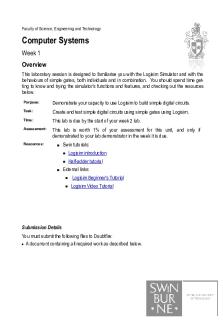Lab1 report template Ingeniería de computadores PDF

| Title | Lab1 report template Ingeniería de computadores |
|---|---|
| Course | Ingeniería de materiales |
| Institution | Universidad de Deusto |
| Pages | 7 |
| File Size | 455.7 KB |
| File Type | |
| Total Downloads | 42 |
| Total Views | 114 |
Summary
Respuestas a Lab1 report template Ingeniería de computadores...
Description
Computers’ Engineering: Lab Report
Lab 1: Mapping Your Circuit to an FPGA Date
Grade
Names
Please check the following indications:
You have to submit this report via ALUD.
Use a zip file that contains: o The filled template report. o All vhd files used for all exercises.
Only one member from each group should submit the report. All members of the group will get the same grade.
The name of the submitted file should be Lab1_LastName1_LastName2.zip, where LastName1 and LastName2 are the last names of the members of the group.
Note 1: Please include all the required material. No links/shortcuts are accepted.
Note 2: The deadline for the report is a hard deadline and it will not be extended.
Note 3: Not meeting these requirements will decrease the final mark, or even invalidate the delivery of the report.
1
Exercise 1. 4-bit adder Design a 4-bit adder using structural modeling. The first step is designing a simple full adder, a 1-bit adder circuit. In the next step, you will instantiate 4 copies of the 1-bit adder to implement a “4-bit Adder”. Finally, you will adapt your program to the remote FPGA platform and get the circuit running on the FPGA board. Map the input operands to eight switches (4 for 1 operand, and 4 for the other) on the board, and map outputs to 5 LEDs on the board. Map your design to the FPGA and check the correctness of your design. Schematic view of the 1-bit adder
Schematic view of the 4-bit adder Screenshot of the remote FPGA performing an operation (please detail which is the operation)
2
Exercise 2. Decoder In this exercise, you will design a Decoder module and implement it using built-in logic gates (e.g., AND, OR, NOT, ...) in VHDL. Here is the description of a 2-input Decoder: The 2-input decoder has 2 inputs and 4 outputs. For any given input, exactly one of the decoder’s outputs is 1; all other outputs are 0. The single output that is logically 1 is the output that corresponds to the input pattern applied to the circuit. For example, the first output of the decoder will be 1 when the input is ‘00’. Map the inputs to two switches on the board, and map outputs to 4 LEDs on the board. Map your design to the FPGA and check the correctness of your design. Schematic view of the decoder
Screenshot of the remote FPGA performing an operation (please detail which is the operation)
3
When all inputs are set to 0 the first output becomes 1.
4
Exercise 3. Multiplexer Design a multiplexer with these features: The multiplexer should select one of 2 inputs and connect it to its output. The selection of which input is routed to the output is controlled by a 1-bit control input. We call this multiplexer a 2:1 MUX. Use several instances of your 2:1 MUX to design a 4:1 MUX. Map your design to your FPGA board, with input and output ports of your choice, and check the functionality of your circuit. Schematic view of the 2 to 1 MUX
Schematic view of the 4 to 1 MUX
5
Screenshot of the remote FPGA performing an operation (please detail which is the operation)
6
When you press KEY0 the FPGA board will use the switches from the left side. Otherwise, will use the switches from the right.
Feedback If you have any comments about the exercise please add them here: mistakes in the text, difficulty level of the exercise, or anything that will help us improve it for the next time.
7...
Similar Free PDFs

lab1 Report- Reflexes
- 5 Pages

Lab1 - Lab Report
- 1 Pages

Lab1 - Lab Report
- 27 Pages

Lab1
- 1 Pages

Lab1
- 5 Pages

Arquitectura de computadores 4
- 2 Pages

GENERACION DE LOS COMPUTADORES
- 25 Pages

Lab1
- 8 Pages
Popular Institutions
- Tinajero National High School - Annex
- Politeknik Caltex Riau
- Yokohama City University
- SGT University
- University of Al-Qadisiyah
- Divine Word College of Vigan
- Techniek College Rotterdam
- Universidade de Santiago
- Universiti Teknologi MARA Cawangan Johor Kampus Pasir Gudang
- Poltekkes Kemenkes Yogyakarta
- Baguio City National High School
- Colegio san marcos
- preparatoria uno
- Centro de Bachillerato Tecnológico Industrial y de Servicios No. 107
- Dalian Maritime University
- Quang Trung Secondary School
- Colegio Tecnológico en Informática
- Corporación Regional de Educación Superior
- Grupo CEDVA
- Dar Al Uloom University
- Centro de Estudios Preuniversitarios de la Universidad Nacional de Ingeniería
- 上智大学
- Aakash International School, Nuna Majara
- San Felipe Neri Catholic School
- Kang Chiao International School - New Taipei City
- Misamis Occidental National High School
- Institución Educativa Escuela Normal Juan Ladrilleros
- Kolehiyo ng Pantukan
- Batanes State College
- Instituto Continental
- Sekolah Menengah Kejuruan Kesehatan Kaltara (Tarakan)
- Colegio de La Inmaculada Concepcion - Cebu







